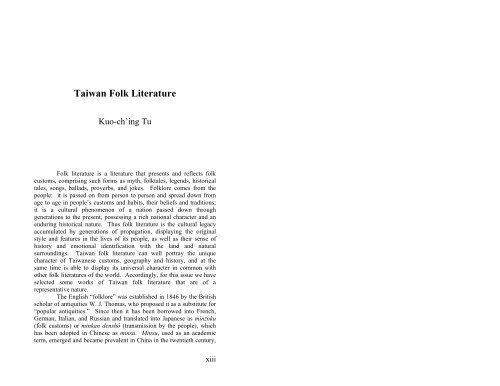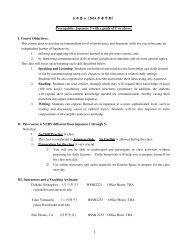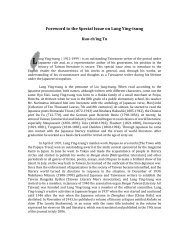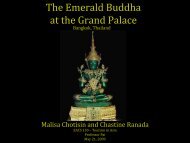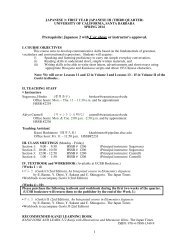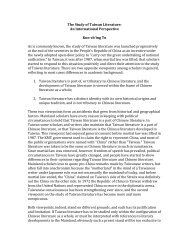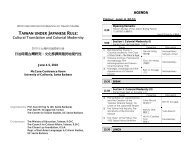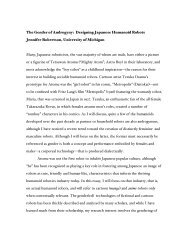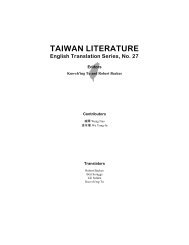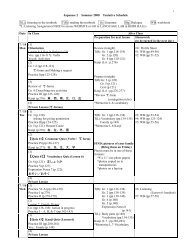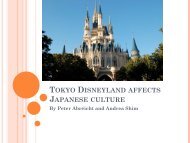Taiwan Folk Literature - Department of East Asian Languages and ...
Taiwan Folk Literature - Department of East Asian Languages and ...
Taiwan Folk Literature - Department of East Asian Languages and ...
You also want an ePaper? Increase the reach of your titles
YUMPU automatically turns print PDFs into web optimized ePapers that Google loves.
<strong>Taiwan</strong> <strong>Folk</strong> <strong>Literature</strong><br />
Kuo-ch’ing Tu<br />
<strong>Folk</strong> literature is a literature that presents <strong>and</strong> reflects folk<br />
customs, comprising such forms as myth, folktales, legends, historical<br />
tales, songs, ballads, proverbs, <strong>and</strong> jokes. <strong>Folk</strong>lore comes from the<br />
people: it is passed on from person to person <strong>and</strong> spread down from<br />
age to age in people’s customs <strong>and</strong> habits, their beliefs <strong>and</strong> traditions;<br />
it is a cultural phenomenon <strong>of</strong> a nation passed down through<br />
generations to the present, possessing a rich national character <strong>and</strong> an<br />
enduring historical nature. Thus folk literature is the cultural legacy<br />
accumulated by generations <strong>of</strong> propagation, displaying the original<br />
style <strong>and</strong> features in the lives <strong>of</strong> its people, as well as their sense <strong>of</strong><br />
history <strong>and</strong> emotional identification with the l<strong>and</strong> <strong>and</strong> natural<br />
surroundings. <strong>Taiwan</strong> folk literature can well portray the unique<br />
character <strong>of</strong> <strong>Taiwan</strong>ese customs, geography <strong>and</strong> history, <strong>and</strong> at the<br />
same time is able to display its universal character in common with<br />
other folk literatures <strong>of</strong> the world. Accordingly, for this issue we have<br />
selected some works <strong>of</strong> <strong>Taiwan</strong> folk literature that are <strong>of</strong> a<br />
representative nature.<br />
The English “folklore” was established in 1846 by the British<br />
scholar <strong>of</strong> antiquities W. J. Thomas, who proposed it as a substitute for<br />
“popular antiquities.” Since then it has been borrowed into French,<br />
German, Italian, <strong>and</strong> Russian <strong>and</strong> translated into Japanese as minzoku<br />
(folk customs) or minkan denshô (transmission by the people), which<br />
has been adopted in Chinese as minsu. Minsu, used as an academic<br />
term, emerged <strong>and</strong> became prevalent in China in the twentieth century,<br />
xiii
around the new cultural movement <strong>of</strong> May Fourth, 1919. Under the<br />
influence <strong>of</strong> the new cultural trends, Peking University established in<br />
1918 an <strong>of</strong>fice to collect folk songs, which were printed in the<br />
university publication. In 1920 the <strong>of</strong>fice was converted into the<br />
Society for the Study <strong>of</strong> <strong>Folk</strong> Songs <strong>and</strong> started to publish Geyao<br />
zhoukan [<strong>Folk</strong>songs Weekly]; it took the lead in the nation for the<br />
process <strong>of</strong> seeking <strong>and</strong> collecting works <strong>of</strong> folk literature. In January <strong>of</strong><br />
1927, the National Sun Yat-sen University in Guangzhou started to<br />
publish Minjian wenyi [<strong>Folk</strong> <strong>Literature</strong> <strong>and</strong> Art] weekly, which was<br />
converted into Minsu [<strong>Folk</strong>lore] weekly, <strong>and</strong> continued until April,<br />
1930, 110 issues in total. It published more than 300 pieces <strong>of</strong> research<br />
material in folk literature, customs, <strong>and</strong> common beliefs, as well as<br />
studies <strong>and</strong> critiques. Its contribution to the establishment <strong>of</strong> modern<br />
folklore study in China is indelible.<br />
In the fifties some folklore scholars moved to <strong>Taiwan</strong> with the<br />
Nationalist government <strong>and</strong> continued their folk studies. The most<br />
important <strong>of</strong> these was Lou Tsu-k’uang, who, in collaboration with<br />
Pr<strong>of</strong>essor Wolfram Eberhard, published Dongfang wencong [Oriental<br />
Culture] weekly, a journal <strong>of</strong> monographs on folklore, <strong>and</strong> launched the<br />
reprinted publication <strong>of</strong> the <strong>Folk</strong>lore <strong>and</strong> <strong>Folk</strong> <strong>Literature</strong> Series <strong>of</strong><br />
National Peking University <strong>and</strong> the Chinese Association for <strong>Folk</strong>lore in<br />
1970, introducing to <strong>Taiwan</strong> the achievements <strong>of</strong> folklore studies from<br />
the mainl<strong>and</strong>. This series has published many hundreds <strong>of</strong> books on<br />
folklore in about ten years, including Lou Tsu-k’uang’s <strong>Taiwan</strong> minjian<br />
gushi [<strong>Folk</strong>tales from Formosa], <strong>Taiwan</strong> suwenxue conghua [Essays on<br />
<strong>Taiwan</strong>ese <strong>Folk</strong> <strong>Literature</strong>], <strong>Taiwan</strong> minsu yuanliu [The Source <strong>of</strong><br />
<strong>Taiwan</strong>ese <strong>Folk</strong>lore], as well as Bei-<strong>Taiwan</strong> fengwu [<strong>Folk</strong>lore <strong>of</strong><br />
Northern <strong>Taiwan</strong>] by Lin Han-tao, et al., Nan-<strong>Taiwan</strong> minsu [<strong>Folk</strong>lore<br />
<strong>of</strong> Southern <strong>Taiwan</strong>] by Chu Feng, <strong>and</strong> Kejia suwenxue [<strong>Folk</strong><br />
<strong>Literature</strong> <strong>of</strong> the Hakka] by Chou Ch’ing-hwa, ed..<br />
Definitions <strong>of</strong> folklore vary among scholars: some take it to<br />
be a cultural presentation <strong>of</strong> the common people in the society while<br />
others emphasize that it represents the tradition <strong>of</strong> an old culture. Due<br />
to regional <strong>and</strong> ethnic differences, folkloric content is not identical; but<br />
there is both a broad <strong>and</strong> narrow sense to the term. In its larger usage,<br />
relative to the high culture <strong>of</strong> the intelligentsia, the term refers to folk<br />
wisdom <strong>and</strong> practical folk knowledge, the lifestyle <strong>and</strong> culture <strong>of</strong><br />
common people. According to the interpretation in The Encyclopedia<br />
Americana (1999), “<strong>Folk</strong>lore, in its broadest sense, is the part <strong>of</strong> the<br />
culture, customs, <strong>and</strong> beliefs <strong>of</strong> a society that is based on popular<br />
tradition.” In its more narrow sense it refers simply to the sphere <strong>of</strong><br />
folk literature <strong>and</strong> art; for example, The American Heritage Dictionary<br />
xiv
efers to “folklore” as “traditional stories <strong>and</strong> legends, transmitted<br />
orally (rather than in writing) from generation to generation.”<br />
The ways to reflect folk lifestyles are many. They consist<br />
principally <strong>of</strong> myths, folktales, legends, fairy tales, humorous tales,<br />
folksongs, proverbs, riddles, folk dance, children’s games, festivals,<br />
superstitions <strong>and</strong> ritual practices, which can be classified into three<br />
categories: folk literature, folk beliefs, <strong>and</strong> folk customs. Among them<br />
myths, legends, <strong>and</strong> folktales are most closely related to literature, <strong>and</strong><br />
quite a few scholars have made their special characteristics topics <strong>of</strong><br />
discussion. The primary differences among these forms are: myths<br />
concern themselves with interpretations <strong>and</strong> beliefs about the origin <strong>of</strong><br />
the universe <strong>and</strong> life <strong>and</strong> death <strong>of</strong> human beings; the backdrop for<br />
legends is the real world, usually concerned with the formation <strong>and</strong><br />
origins <strong>of</strong> places (locales <strong>and</strong> natural conditions), history (the<br />
beginnings <strong>of</strong> states, the rise <strong>and</strong> fall <strong>of</strong> dynasties, <strong>and</strong> other significant<br />
events), as well as the description <strong>of</strong> behaviors <strong>and</strong> affairs <strong>of</strong> people<br />
(heroes, great talents, sages, <strong>and</strong> eccentrics); folktales take events from<br />
the real, vulgar world <strong>and</strong> transform them into fictive accounts, <strong>and</strong><br />
<strong>of</strong>ten they incorporate in these accounts fantasies, phenomena, nature,<br />
behavior <strong>and</strong> events <strong>of</strong> animals <strong>and</strong> human beings with no definite time,<br />
place, or setting. The most common folktales are fables, the märchen,<br />
<strong>and</strong> jokes, <strong>and</strong> they <strong>of</strong>ten express idealistic wishes <strong>and</strong> hopes, moral<br />
teachings, criticisms <strong>of</strong> the real world, <strong>and</strong> derision <strong>of</strong> human nature.<br />
Myths, folktales, <strong>and</strong> legends <strong>of</strong>ten become subject matters <strong>and</strong> sources<br />
<strong>of</strong> inspiration for literature, painting, music, sculpture <strong>and</strong> other artistic<br />
pursuits. <strong>Folk</strong> songs <strong>and</strong> daily life are closely related; the singing <strong>of</strong><br />
songs expresses the sorrows <strong>and</strong> joys, the sadness <strong>and</strong> the happiness <strong>of</strong><br />
the common people. Festival celebrations largely take folkloric<br />
activities to be their primary content; many consist <strong>of</strong> superstitious<br />
beliefs <strong>and</strong> habits. The origination <strong>of</strong> folklore among primitive<br />
societies is facilitated through oral transmission, not in the form <strong>of</strong><br />
literature that is written down in books. Since histories were recorded,<br />
scholars began to record <strong>and</strong> collect folk materials; on the one h<strong>and</strong> this<br />
is a search for a source <strong>of</strong> inspiration, but at the same time it is a<br />
preservation <strong>of</strong> the national cultural heritage.<br />
From this, we take “folk literature” to be “a literature that<br />
displays folkways.” Generally, the particular features <strong>of</strong> folk literature<br />
are its oral nature (relying on oral transmission for its creation <strong>and</strong><br />
propagation), its collective authorship (being created collectively by the<br />
messes), its modular variability (varying in its structure, form, <strong>and</strong><br />
theme because <strong>of</strong> different times, places, <strong>and</strong> persons involved), <strong>and</strong> its<br />
manner <strong>of</strong> transmission (passed on from generation to generation, from<br />
mouth to mouth). Therefore its content, its language expression <strong>and</strong> its<br />
xv
method <strong>of</strong> dissemination are very different from authorial works <strong>and</strong><br />
written literature (although in the final analysis they <strong>of</strong>ten influence<br />
each other). Within a country with many distinct ethnic groups,<br />
exchange <strong>and</strong> influence <strong>of</strong>ten happen among the folk literatures <strong>of</strong><br />
different ethnic groups <strong>and</strong> folk cultures. Such is the situation within<br />
the Han people’s culture, where there are different dialect groups, as<br />
well as between the Han <strong>and</strong> other minor ethnic groups, where the<br />
differences are even sharper. Therefore between the folk literature <strong>of</strong><br />
<strong>Taiwan</strong> <strong>and</strong> the other folk literatures <strong>of</strong> mainl<strong>and</strong> China, inevitably<br />
there are many similarities in character due to similar cultures <strong>and</strong><br />
cultural backgrounds; while, because <strong>of</strong> differences in social<br />
development <strong>and</strong> historical precedents, <strong>Taiwan</strong> produced a folk<br />
literature that is unique <strong>and</strong> disseminated only in <strong>Taiwan</strong>. On the other<br />
h<strong>and</strong>, among folk literatures <strong>of</strong> different regions <strong>and</strong> different cultures<br />
in the world, there are many similarities between concepts <strong>and</strong> methods<br />
<strong>of</strong> portrayal; so much so that fundamental characters <strong>and</strong> plots have<br />
largely the same form. This could perhaps be due to direct or indirect<br />
influence <strong>of</strong> propagation in the course <strong>of</strong> history, or possibly it is<br />
because <strong>of</strong> the universal nature <strong>of</strong> folk literature as a creative work <strong>of</strong><br />
common human thinking, feelings <strong>and</strong> imagination. The influence <strong>and</strong><br />
exchange <strong>of</strong> folk literature among regions <strong>and</strong> ethnic groups around the<br />
world can provide a very interesting subject for comparative literature<br />
<strong>and</strong> comparative culture studies.<br />
The residents <strong>of</strong> <strong>Taiwan</strong>, aside from the aboriginal peoples,<br />
are all immigrants from the mainl<strong>and</strong>, having come over during the<br />
Ming <strong>and</strong> Qing dynasties, primarily the Minnan (southerners from<br />
Fujian, especially from Zhangzhou <strong>and</strong> Quanzhou) <strong>and</strong> the Hakka from<br />
Guangdong; these three constitute <strong>Taiwan</strong>’s population <strong>of</strong> ethnocultural<br />
groups, <strong>and</strong> hence the origins <strong>of</strong> <strong>Taiwan</strong> folk literature. Of the<br />
aboriginal peoples, there are nine tribes, <strong>and</strong> their folk literature is<br />
particularly concerned with myths about the origins <strong>of</strong> human beings<br />
<strong>and</strong> the perception <strong>of</strong> the world. Their characteristic features have<br />
already been presented in quite a few prominent studies by scholars.<br />
The folktales <strong>of</strong> the Minnan <strong>and</strong> Hakka people in <strong>Taiwan</strong> have a link <strong>of</strong><br />
blood <strong>and</strong> culture with the Chinese mainl<strong>and</strong>ers, <strong>and</strong> this was what,<br />
during the sixties, Lou Tsu-k’uang’s efforts to compile, organize, <strong>and</strong><br />
translate a collection <strong>of</strong> data <strong>and</strong> research on <strong>Taiwan</strong> folk literature<br />
tried to emphasize. (See his “Foreword” to <strong>Taiwan</strong> suwenxue conghua<br />
[Series in <strong>Taiwan</strong> <strong>Folk</strong> <strong>Literature</strong>].) Pr<strong>of</strong>essor Shih Ts’ui-feng has also<br />
maintained, “<strong>Folk</strong>tales in <strong>Taiwan</strong> <strong>and</strong> those <strong>of</strong> southern China both<br />
come from the same source . . . mostly from the Tang <strong>and</strong> Song<br />
dynasties, due to the moving <strong>of</strong> ethnic groups <strong>and</strong> their immigration to<br />
the south from central China, so that the language <strong>of</strong> these southern<br />
xvi
Han peoples, their customs, practices, <strong>and</strong> so on are all richly preserved<br />
from their ancestral regions in central China; that this is true is without<br />
a doubt” (“Introduction” to <strong>Taiwan</strong> mintan tanyuan [A Study <strong>of</strong> the<br />
Source <strong>of</strong> <strong>Taiwan</strong>ese <strong>Folk</strong>tales]).<br />
However, <strong>Taiwan</strong> is surrounded on all four sides by the ocean,<br />
<strong>and</strong> has three hundred years <strong>of</strong> historical experience, <strong>and</strong> in the final<br />
analysis this enabled <strong>Taiwan</strong> folk literature to portray its own time,<br />
place, <strong>and</strong> social reality, its own environment, types <strong>of</strong> lifestyle, <strong>and</strong><br />
humanistic colors <strong>and</strong> to develop its own special texts with different<br />
settings <strong>of</strong> time <strong>and</strong> space. With the texts selected for this issue, we<br />
hope to be able to represent these unique characteristics. As for<br />
aboriginal folktales, we have selected myths <strong>and</strong> legends <strong>of</strong> the Bunan,<br />
Saisiat, Paiwan <strong>and</strong> Yami peoples. For the works <strong>of</strong> the Minnan, we<br />
have chosen the most common folktales, “Auntie Tiger” <strong>and</strong> “Seven<br />
Strange Brothers”; for legends, we have selected “Anecdotes <strong>of</strong> Liar<br />
Seven,” “Ku Bonsia’s Pranks,” <strong>and</strong> “The Silver Coin Tree”; <strong>and</strong> for<br />
historical tales we have “Koxinga Marches North,” “The Duck King,”<br />
<strong>and</strong> “Seventh Lord <strong>and</strong> Eighth Lord.” Besides these, we have carefully<br />
selected one piece <strong>of</strong> the Hakka people’s folklore, the common tale<br />
“Nine-Generations-Poor.” “Auntie Tiger” may be heard at the door <strong>of</strong><br />
every home at dusk. According to Lou’s surveys, tales resembling<br />
“Auntie Tiger” are also popular in the mainl<strong>and</strong> provinces, <strong>and</strong> they<br />
can in fact be heard in many parts <strong>of</strong> the world, although the elements<br />
<strong>of</strong> the tale are not exactly alike, even if the plots are basically similar.<br />
(See <strong>Taiwan</strong> suwenxue de yanjiu [A Study <strong>of</strong> <strong>Taiwan</strong> <strong>Folk</strong> <strong>Literature</strong>],<br />
included in Minsu congshu [<strong>Folk</strong>lore <strong>and</strong> <strong>Folk</strong> <strong>Literature</strong> Series], no. 52,<br />
1971.) Sociologist Wolfram Eberhard <strong>of</strong> The University <strong>of</strong> California<br />
at Berkeley has published a book on these common tales <strong>and</strong> their<br />
variants. (See Studies in <strong>Taiwan</strong>ese <strong>Folk</strong>tales, <strong>Asian</strong> <strong>Folk</strong>lore <strong>and</strong><br />
Social Life Monographs, vol. 1, March 1970.) Lin Chen-mei <strong>of</strong> Ts’ing<br />
Hua University also has published “A Study <strong>of</strong> ‘Auntie Tiger.’” (See<br />
Proceedings <strong>of</strong> the First Conference on <strong>Taiwan</strong> <strong>Folk</strong> <strong>Literature</strong>, June<br />
1997.) “Anecdotes <strong>of</strong> Liar Seven” was popular in the Tainan area, <strong>and</strong><br />
Lin P’ei-ya <strong>of</strong> Ts’ing Hua University, in addition to his M.A. thesis,<br />
“<strong>Taiwan</strong> diqu Qiu Wangshe gushi yanjiu” [A Study <strong>of</strong> the Story <strong>of</strong> Ku<br />
Bonsia in <strong>Taiwan</strong>],” had conducted a survey <strong>of</strong> field research on the<br />
changes <strong>and</strong> variations <strong>of</strong> this tale in Tainan city, published in the<br />
above Proceedings). Because most <strong>of</strong> the available data <strong>of</strong> common<br />
folktales come in different written versions depending on the writers,<br />
we have selected those stories that are most complete, in order to have<br />
better readability in translation.<br />
As for poetry, in order to coordinate it with our theme <strong>and</strong> the<br />
two essays on <strong>Taiwan</strong> native folksongs, we have selected four such<br />
xvii
songs that have enjoyed great popularity. Due to these pieces being<br />
originally sung, their artistic merit lies primarily in their tune, where<br />
the literal meaning <strong>of</strong> the lyrics is secondary; we hope that the selected<br />
four songs still show their originality as creative works after translation,<br />
although their literary quality has been much weakened.<br />
Regarding studies in <strong>Taiwan</strong> folk literature, we have selected<br />
three pieces: Pr<strong>of</strong>essor Hu Wan-ch’uan’s article “<strong>Taiwan</strong> minjian<br />
wenxue de guoqu yu xianzai” [The Past <strong>and</strong> Present <strong>of</strong> <strong>Taiwan</strong>ese <strong>Folk</strong><br />
<strong>Literature</strong>] (1993), although not the most recent, has provided some<br />
very excellent background data including research materials published<br />
during the Japanese rule <strong>and</strong> after the war. Based on it, Peng Yan-lun’s<br />
“Qianlun <strong>Taiwan</strong> minjian gushi fazhan gaikuang” [A Survey <strong>of</strong> the<br />
Development <strong>of</strong> <strong>Taiwan</strong>ese <strong>Folk</strong>tales], Guoli Zhongyang Tushuguan<br />
<strong>Taiwan</strong> fenguan guankan [Bulletin <strong>of</strong> National Central Library <strong>Taiwan</strong><br />
Branch], vol. 5, no. 2 (December 31, 1998) has some new information<br />
added as a useful reference. Liu Shu-ch’in’s article “Ri-zhi moqi<br />
Chang Wen-huan xiaoshuo zhongde minsu-feng” [Ethnographic Style<br />
in the Short Stories <strong>of</strong> Chang Wen-huan During the Latter Period <strong>of</strong><br />
Japanese Rule], translated by Pr<strong>of</strong>essor Douglas Fix, has substantially<br />
enriched the content <strong>of</strong> this issue. Pr<strong>of</strong>essor Boris Riftin, a<br />
Corresponding Member <strong>of</strong> the Division <strong>of</strong> <strong>Literature</strong> <strong>and</strong> Language, the<br />
Russian Academy <strong>of</strong> Sciences, is a well-known sinologist, whose<br />
research emphases are Chinese folk literature <strong>and</strong> classical fiction; in<br />
recent years, his research has been devoted to the folklore <strong>of</strong> aboriginal<br />
peoples in <strong>Taiwan</strong>. His book Cong shenhua dao guihua—<strong>Taiwan</strong><br />
yuanzhumin shenhua gushi yanjiu [From Myths to Ghost Stories—<br />
Comparative Studies on <strong>Taiwan</strong> Aboriginal Tales] has provided<br />
analyses <strong>and</strong> interpretations <strong>of</strong> the myths from historical <strong>and</strong><br />
geographical comparative perspectives, <strong>and</strong> has attracted great attention<br />
from scholars in the field. The appendix, “Bibliography <strong>of</strong> Studies <strong>of</strong><br />
<strong>Taiwan</strong> Myths, Legends <strong>and</strong> Common Tales,” consists <strong>of</strong> 159 titles<br />
altogether as the most exhaustive source for the subject. In recent years,<br />
<strong>Taiwan</strong> has convened many folk literature conferences, such as the<br />
“International Conference on <strong>Folk</strong> <strong>Literature</strong>s” <strong>and</strong> the “Conference on<br />
Chinese Mythology <strong>and</strong> Tradition,” sponsored by the Center for<br />
Chinese Studies in 1989 <strong>and</strong> 1995, <strong>and</strong> “The First Conference on<br />
<strong>Taiwan</strong> <strong>Folk</strong> <strong>Literature</strong>,” sponsored by the Huangxi Cultural Society in<br />
1997, all with proceedings published.<br />
For the successful printing <strong>of</strong> this issue, we have to thank the<br />
dedication <strong>and</strong> cooperation <strong>of</strong> many translators, among whom we have<br />
several who contribute so regularly that it would seem they are our<br />
special contributors; their willingness to apply such a large amount <strong>of</strong><br />
effort <strong>and</strong> assistance in the act <strong>of</strong> translating <strong>Taiwan</strong> literature gives us<br />
xviii
much encouragement in this enterprise. Finally, a note regarding<br />
romanization <strong>of</strong> Chinese characters. Certain readers have presented to<br />
us their opinions on the matter, inducing us to reconsider the issue.<br />
Due to the <strong>Taiwan</strong> government’s hesitancy on the matter <strong>of</strong> which<br />
romanization system they will eventually adopt, those <strong>of</strong> us who work<br />
to translate <strong>Taiwan</strong> literature into English are faced with a problem that<br />
is puzzling to resolve. In the summer <strong>of</strong> 1999 it was said that <strong>Taiwan</strong><br />
would <strong>of</strong>ficially switch from Wade-Giles romanization to Hanyu pinyin,<br />
<strong>and</strong> because <strong>of</strong> this, in the sixth issue <strong>of</strong> this journal (December, 1999)<br />
we began to use Hanyu pinyin to transcribe Chinese characters. Last<br />
year the same issue was brought up again in the newspapers, <strong>and</strong><br />
apparently the Executive Yuan <strong>and</strong> the Education Ministry had not<br />
reached an agreement <strong>and</strong> the issue is still pending. Because the U.S.<br />
Library <strong>of</strong> Congress, in October <strong>of</strong> 2000, <strong>of</strong>ficially adopted Hanyu<br />
pinyin as the st<strong>and</strong>ard system <strong>of</strong> romanization for their catalogue, this<br />
will necessarily accelerate the tendency to replace Wade-Giles with<br />
Hanyu pinyin among English translations from Chinese in the<br />
academic world. Generally speaking, in the articles <strong>of</strong> this issue, we<br />
have opted to use Hanyu pinyin for proper names, book titles, <strong>and</strong><br />
names <strong>of</strong> characters in a story. However, before the <strong>Taiwan</strong><br />
government has made a definite decision on which system to use, if we<br />
hurriedly use Hanyu pinyin to transcribe all the personal <strong>and</strong> place<br />
names originating in <strong>Taiwan</strong>, it could seem like a presumptuous<br />
disregard <strong>of</strong> <strong>Taiwan</strong>ese practice in their own affairs. Therefore, for the<br />
names <strong>of</strong> people from <strong>Taiwan</strong>, we will try to respect their own choices<br />
<strong>of</strong> spelling (if we know them), <strong>and</strong> otherwise retain the Wade-Giles<br />
romanization. For geographical names in <strong>Taiwan</strong>, we will also use<br />
Wade-Giles <strong>and</strong>, following the common practice, omit the markers <strong>of</strong><br />
aspirates (’) <strong>and</strong> hyphens (-) in the case <strong>of</strong> well-known place names.<br />
xix


